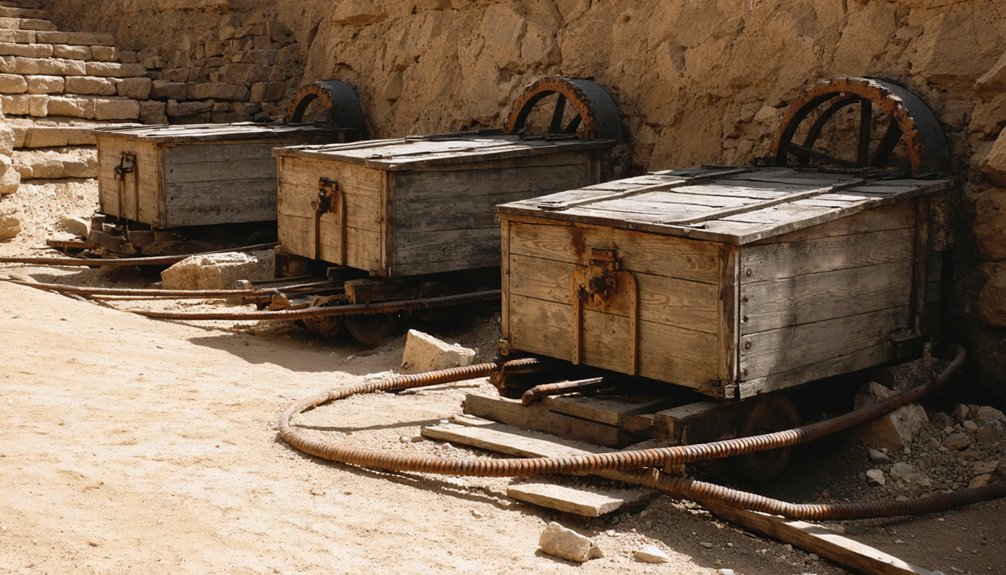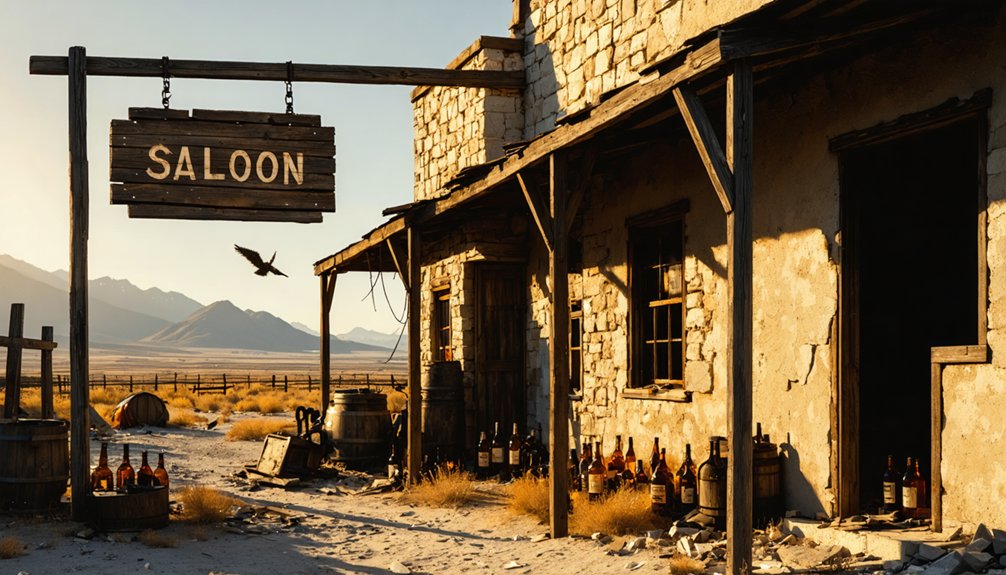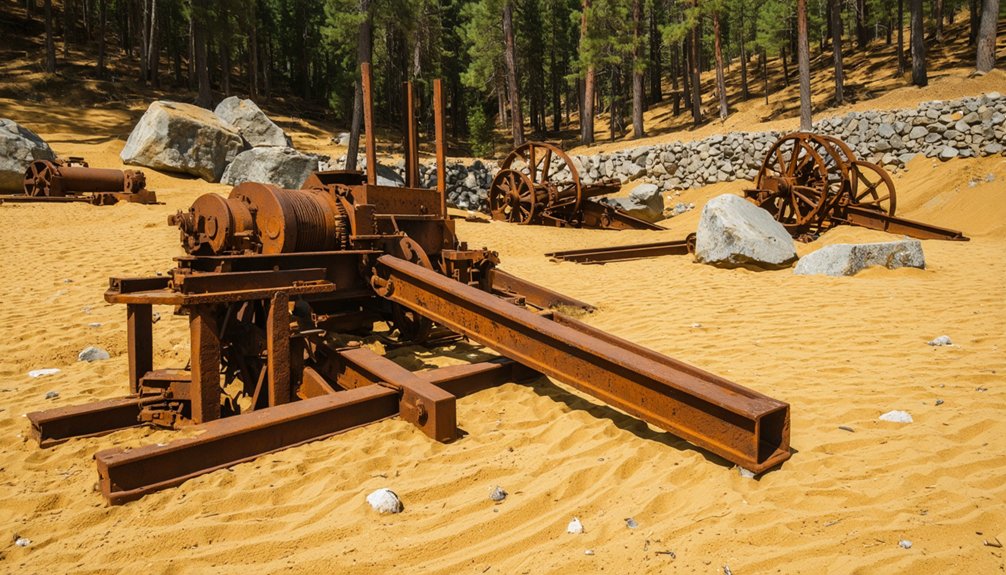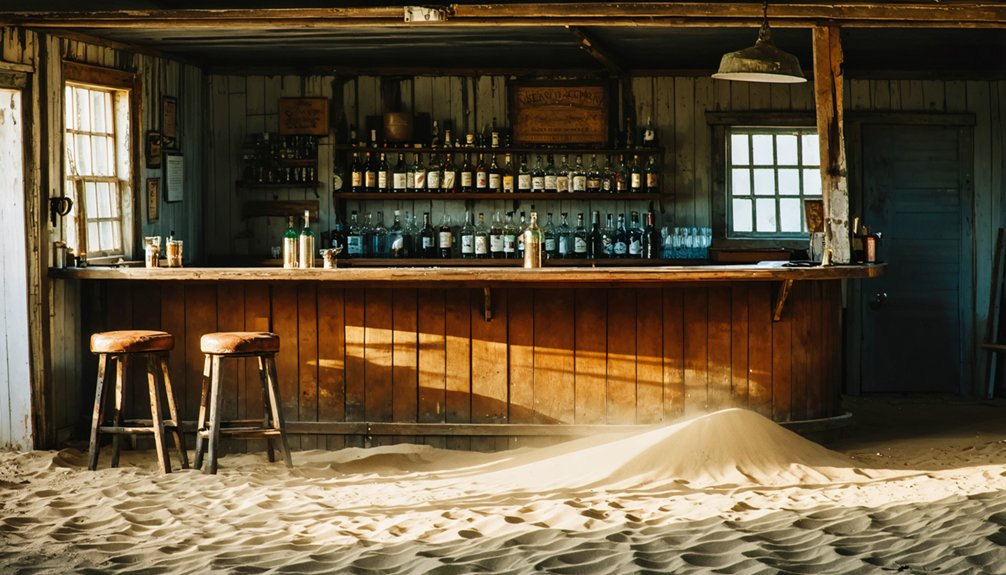El Dorado Bar emerged in the 1850s along the American River in California as a gold mining settlement. You’ll find its original location now submerged beneath Folsom Lake, though historical markers remain throughout El Dorado County. The town flourished briefly with saloons, stores, and diverse residents before declining when placer gold deposits dwindled by 1861. A devastating flood in 1862 sealed its fate. The ghost town’s rich history reveals much about California’s tumultuous mining era.
Key Takeaways
- El Dorado Bar was established in the 1850s along the American River during the California Gold Rush.
- The once-thriving mining settlement declined after gold deposits were exhausted by late 1861.
- A catastrophic flood in 1862 destroyed buildings and infrastructure, accelerating the town’s abandonment.
- The original settlement site is now submerged beneath Folsom Lake in El Dorado County.
- Visitors can access remaining ghost town elements near San Gabriel River while respecting historical preservation guidelines.
The Birth of El Dorado Bar During the Gold Rush
When gold was discovered at Sutter’s Mill in 1848, it set off a chain reaction that would give birth to countless settlements throughout California, including the now-forgotten El Dorado Bar.
This settlement emerged in the early 1850s along the American River in El Dorado County, at the height of gold rush origins. Named after the Spanish term for “the gilded one,” El Dorado Bar attracted prospectors seeking fortune in the placer deposits of the riverbed. The area became known to gold seekers like Charles Peck, who documented his experiences at nearby Fords Bar in 1850.
You’d have witnessed remarkable settlement growth as hundreds flocked to the area, transforming a wilderness outpost into a bustling community within months. The town quickly established essential services—saloons, stores, and lodgings—to accommodate the diverse international population drawn by golden promises. Like many boomtowns of the era, El Dorado Bar saw an influx of eager 49ers who abandoned previous lives in hopes of striking it rich.
Geographic Features and Natural Setting
Nestled within the rugged terrain of the San Gabriel Mountains, El Dorado Bar occupied a strategic position approximately 4 miles up the East Fork of the San Gabriel River on the north side of East Fork Road in Azusa, California.
At 1,866 feet elevation, the settlement contended with significant terrain challenges typical of Southern California mining camps. The narrow canyon provided limited flat land for development while exposing inhabitants to flash flood dangers. Similar to El Dorado’s location in California, the town enjoys cool winters and warm summer temperatures.
Water resources proved both blessing and curse—the confluence of the main river with Cattle Canyon Creek supplied essential water for mining operations and daily use, yet brought devastating floods, including one that destroyed the original settlement in 1859. The Great Flood of 1862 was particularly catastrophic, with continuous rain from December 24 to January 18 culminating in a wall of water that destroyed much of Eldorado Ville.
The Mediterranean climate delivered hot, dry summers and cool, wet winters, supporting a diverse ecosystem of chaparral, oaks, and riparian vegetation.
Daily Life in a Mining Community
Walking into El Dorado Bar’s saloon, you’d have encountered the heart of social life where miners gathered to drink, gamble, and escape the harsh realities of their laborious existence.
Behind the mainly male façade of mining life, women operated boarding houses, laundries, and restaurants, providing essential services that sustained the community. Mrs. A. Harris made history as the first woman to settle in the area, paving the way for other female residents who would follow. The town’s diverse population included various ethnic groups, such as Mexicans and Chinese miners who contributed to the cultural tapestry of the settlement.
Their contributions, though rarely documented in official records, created the foundation of stability that transformed temporary encampments into functioning settlements.
Saloon Culture Thrived
In the heart of El Dorado Bar‘s daily life, the saloon emerged as more than a simple drinking establishment; it became the community’s vibrant nucleus. You’d find miners gathering after long shifts, exchanging news while enjoying whiskey or beer.
These establishments served as unofficial town halls where disputes were settled and business deals struck.
Saloon entertainment varied from simple card games to occasional musical performances, creating moments of respite in the harsh mining existence. Inspired by local musical traditions, the Georgia Slide Brass Band would sometimes perform at these establishments, bringing cultural enrichment to the mining community. Community gatherings often centered around these establishments, where celebrations and political meetings naturally took place.
The multicultural atmosphere reflected El Dorado Bar’s diverse population, with patrons from various backgrounds sharing stories and forming bonds. Racial tensions that eventually led to violent massacres elsewhere in Gold Rush towns were sometimes temporarily subdued within these social spaces.
Saloon keepers extended credit during tough times, becoming influential figures who often shaped the community’s development as much as any elected official.
Women’s Hidden Contributions
While men’s gold-seeking exploits dominate El Dorado Bar’s historical record, women’s contributions formed the essential backbone of daily life that sustained the community.
Through largely invisible women’s labor, these pioneers transformed El Dorado Bar from a transient camp into a functioning society. The museum’s Research Room provides valuable documentation of these overlooked contributions to county history.
- Operated essential boarding houses and laundry services that provided miners clean clothes and decent lodging
- Established impromptu medical care, nursing injured miners with home remedies when no doctors existed
- Managed household economies and often ran small businesses selling necessities
- Organized social gatherings that maintained community morale amid harsh conditions
- Created informal education for children, planting seeds for eventual schools
These domestic roles rarely appeared in official histories, yet archaeological evidence reveals their profound impact—household artifacts telling stories of adaptation and resilience in California’s unforgiving gold country. Similar to the now-submerged Condemned Bar settlement, many of these women’s stories remain hidden beneath the surface of mainstream historical accounts.
Notable Characters and Colorful Residents
The ghost town of El Dorado Bar was home to numerous intriguing personalities who shaped its development and cultural landscape during the gold rush era. Ephraim “Yank” Clement operated a popular stage stop at Mud Springs (later El Dorado), providing essential services for travelers along the Placerville-Carson Road, exemplifying the entrepreneurial spirit that drove settlement.
Martin Smith’s 1851 trading post became central to early commerce, while John Tong’s private toll road improved regional accessibility.
These pioneers demonstrated remarkable community resilience following the devastating 1859 flood that destroyed Prospect Bar, prompting settlers to rebuild and establish the Eldorado Mining District.
Chinese residents contributed considerably despite facing violence, including a tragic massacre in Volcanoville.
Bob Haslam, the notable Pony Express rider, represented El Dorado’s importance in early transcontinental communication networks.
Mining Techniques and Gold Production

Beyond the notable personalities who shaped El Dorado Bar‘s social landscape, understanding how gold was extracted reveals much about the settlement’s economic foundation.
El Dorado’s true story lies not just in its people, but in the gold-rich soil that birthed its very existence.
The primary method was alluvial mining, where you’d extract gold from river gravels using various techniques:
- Panning served as the foundational method, allowing miners to identify gold presence
- Sluice boxes and high bankers processed larger volumes of gold-bearing material efficiently
- Grizzlies sorted rocks and boulders, allowing finer gold-containing sediments to pass through
- Water-based washing separated gold from lighter materials due to its higher density
- Hydraulic monitors (“giants”) represented significant mining innovations in gold extraction
Operations adapted to different terrains through bar claims, bench claims, and river-bed claims.
Though production data remains scarce, El Dorado Bar was classified as a medium-sized producer, yielding both gold and sapphires.
Architecture and Physical Remains
Exploring El Dorado Bar‘s physical landscape reveals a settlement once nestled along the North Fork of the American River in California’s Sierra Nevada foothills, now permanently submerged beneath Folsom Lake.
This ghost town architecture primarily consisted of practical log and wooden frame structures built from locally sourced timber—reflecting the transient, utilitarian design common in Gold Rush boomtowns.
You’ll find no visible submerged remains today, as the town vanished under water during dam construction. The settlement once featured basic commercial buildings, residential cabins, and mining support structures like stamp mills and sluices.
While the original site lies underwater, nearby historical markers commemorate its existence. Some artifacts and contextual insights can be found in surrounding El Dorado County museums and ghost towns, preserving the memory of this brief but significant chapter in California’s history.
The Decline of a Boom Town

While El Dorado Bar‘s physical structures now rest beneath Folsom Lake, their disappearance began long before the waters rose. The town’s declining prosperity followed a familiar pattern seen in countless California mining towns, with several factors hastening its demise:
- Mining challenges intensified as easily accessible placer gold became exhausted by late 1861.
- The catastrophic 1862 flood destroyed buildings, equipment, and mining infrastructure.
- Economic collapse occurred when Wells Fargo’s monthly gold shipments dwindled from $15,000.
- Rampant lawlessness outside the regulated mining operations deterred stable settlement.
- Lack of economic diversification left the community vulnerable when gold yields diminished.
You’d find that unlike other settlements that evolved into permanent communities, Eldoradoville’s complete dependence on gold extraction meant that when the flood waters receded, the town’s reason for existence had washed away with them.
Surrounding Ghost Towns and Mining Camps
El Dorado Bar didn’t exist in isolation, but rather formed part of a rich tapestry of mining settlements that dotted California’s gold country during the mid-19th century.
Within this network, Eldoradoville history stands as particularly notable, with the settlement supporting 400 voters by 1860 at its 1866-foot elevation near the junction of East Fork River and Cattle Canyon Creek.
Eldoradoville thrived as a mining community of 400 voters nestled at 1866 feet where East Fork River meets Cattle Canyon Creek.
Just four miles upriver, Prospect Bar revival occurred quickly following devastating floods in 1859.
The broader El Dorado Mining District encompassed numerous operations where miners, laborers, and merchants created vibrant communities until natural disasters struck.
Nearby, towns like El Dorado (formerly Mud Springs) and Shingle Springs preserved their heritage through surviving brick structures from the 1850s, including the Wells Fargo office that stands as testimony to these settlements’ former prominence along the Carson Pass emigrant route.
How to Visit El Dorado Bar Today

You’ll find El Dorado Bar ghost town near the East Fork of the San Gabriel River in Azusa, California, accessible via East Fork Road with parking available at the nearby campground.
When exploring the site, wear sturdy footwear for the rugged terrain and bring necessary supplies as amenities are limited or non-existent.
Remember to respect the historical significance of the area by staying on marked trails, avoiding artifact removal, and checking with local officials about current access conditions.
Finding the Site
Finding El Dorado Bar today requires careful preparation and navigation through the remote wilderness of the San Gabriel Mountains.
The ghost town‘s remains lie approximately 4 miles up the East Fork of the San Gabriel River at an elevation of 1,866 feet, within what’s now called Eldoradoville Campground near Azusa.
To locate this forgotten piece of California’s gold rush history:
- Begin your journey at East Fork Road in Azusa, using Camp Williams (24210 East Fork Road) as your reference point
- Follow historical maps that indicate the junction of the main San Gabriel River and Cattle Canyon Creek
- Prepare for rugged terrain with minimal signage and possible river crossings
- Check Angeles National Forest access routes for closures before departing
- Bring GPS and offline navigation as cell service is nonexistent
Preservation Guidelines
When visiting the historic remains of El Dorado Bar today, preservation must be your primary concern, as this fragile site falls under both federal and California state legal protections that strictly prohibit artifact removal or site disturbance.
Even small items like nails are protected by law, with volunteer groups and trail cameras actively monitoring compliance.
Embrace the “take only photographs, leave only footprints” principle that defines modern preservation ethics. Stick to established trails, cross water only at designated fords, and carry out all trash.
Understanding El Dorado Bar’s significance as a Gold Rush mining camp enhances your appreciation while promoting artifact protection.
Before visiting, check current access conditions with state park officials or local historical societies. Remember, your responsible behavior guarantees these historical treasures remain intact for future generations to discover.
Preserving El Dorado Bar’s Historical Legacy
Despite its decline from a bustling Gold Rush settlement to a ghost town, El Dorado Bar’s historical legacy remains safeguarded through extensive preservation efforts spanning legal, community, and cultural domains.
You’ll find both federal and state laws prohibit artifact removal, with volunteers monitoring the site to prevent theft and vandalism.
The community’s dedication to historical education manifests through:
- Annual cultural events and reenactments similar to Clarksville Day
- Documentation through photography and mapping before further deterioration occurs
- Repurposing of historical structures to maintain physical connections to the past
- Volunteer-led maintenance and research initiatives
- Online resources promoting conservation principles like “take only photographs, leave only footprints”
These preservation strategies guarantee El Dorado Bar’s story endures despite challenges from natural elements and limited funding.
Frequently Asked Questions
Were There Any Major Crimes or Unsolved Mysteries at El Dorado Bar?
While no major El Dorado crimes were specifically documented, you’d find the area experienced violence and vigilantism. Mining law enforcement was weak, fostering an environment where unsolved mysteries likely remained unrecorded.
What Indigenous Tribes Occupied the Area Before the Gold Rush?
Like rivers merging into greater waters, the Miwok and Nisenan (Southern Maidu) tribes inhabited El Dorado before gold’s glitter. Their tribal history and cultural significance remained unbroken until the devastating 1849 rush.
Did Any Famous Gold Rush Era Celebrities Visit El Dorado Bar?
No famous visitors or celebrity encounters at El Dorado Bar are documented in historical records. You won’t find evidence of notable Gold Rush figures visiting this particular mining camp specifically.
Were There Documented Paranormal Experiences or Ghost Stories?
You’ll find documentation of nearby ghost sightings at Cary House and El Dorado Chamber, but El Dorado Bar itself lacks specific haunted tales despite its flood-related demise and mining history.
How Did Seasonal Weather Patterns Affect Mining Operations?
You’d find your mining techniques severely constrained by weather impacts: spring snowmelt enabled placer operations, winter rains flooded shafts, summer droughts halted hydraulic mining, and seasonal floods damaged critical infrastructure.
References
- https://www.youtube.com/watch?v=Egy9mMTVKmo
- https://www.stylemg.com/2017/04/25/140586/in-history-el-dorado-county-ghost-town-clarksville
- https://kaelewis.com/images/california1851.pdf
- https://ohp.parks.ca.gov/?page_id=21417
- https://en.wikipedia.org/wiki/List_of_ghost_towns_in_California
- https://nvtami.com/el-dorado-county-california-ghost-towns/
- https://visit-eldorado.com/historic-towns/
- https://pitsenberger.com/blog/category/Ghost+Towns
- https://www.lombardhistory.org/blog/2022/5/28/charles-peck-the-california-gold-rush
- https://history.howstuffworks.com/american-history/gold-rush.htm



